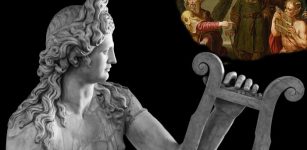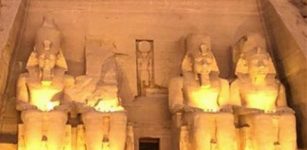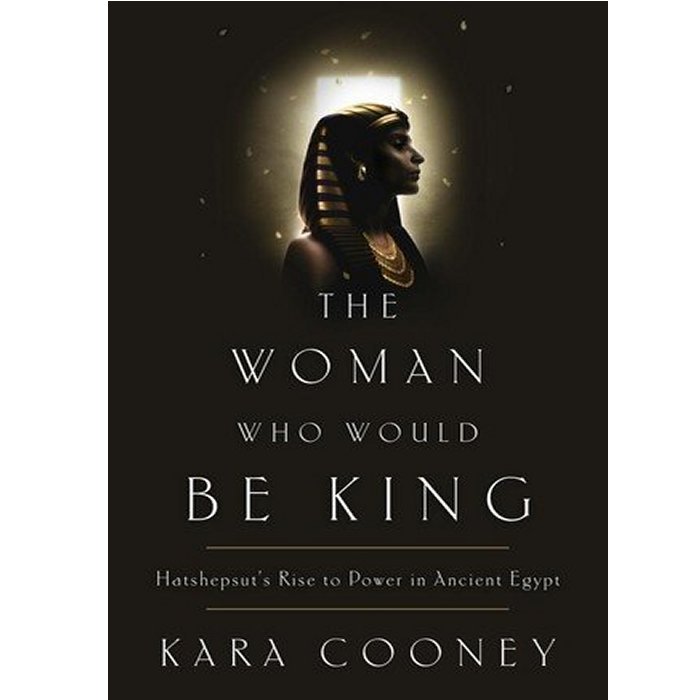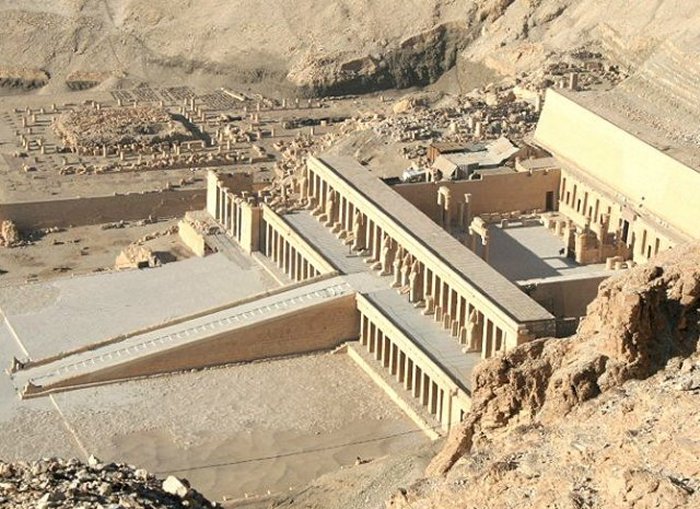Why Was Pharaoh Hatshepsut’s Reign Virtually Erased From History?
Ellen Lloyd - AncientPages.com - Pharaoh Hatshepsut was a remarkable female who was just as successful as strong.
Yet, for some reason, she seems to have been deliberately forgotten.
Hatshepsut was the fifth pharaoh of the Eighteenth dynasty of Egypt. Hatshepsut came to the throne of Egypt in 1478 BC. Officially, she ruled jointly with Thutmose III, who had ascended to the throne as a child one year earlier.
This was a time of prosperity and dominance for Egypt. When Hatshepsut was 20 years, and her husband-brother died, she catapulted herself into the highest office in the land" via a series of shrewd strategies that outgunned supporters of the infant boy-king originally destined for the throne.
Temple of Hatshepsut
In her new book, The Woman Who Would Be King: Hatshepsut’s Rise to Power in Ancient Egypt, UCLA Egyptologist Kara Cooney provides a clear-eyed perspective on how the young Hatshepsut maneuvered her powerful rise and explains why distrust of strong female leaders caused Hatshepsut's reign to be virtually erased from history.
In an interview with the Good Magazine, Cooney revealed how this powerful female leader came to be "king."
This is what Cooney had to say:
Why should we know about Hatshepsut?
She’s the only woman from all of antiquity to have left her situation better than she found it. Other women who held military power are all associated with crisis or disaster. Hatshepsut does everything right, everything was good in her reign. There were no assassinations, only prosperity. In fact, some accused her of giving too much of that wealth away.
Why isn’t she a household name?
Her success precisely is the reason we don’t remember her. We are still quite ambivalent about a female in power.
A woman who has succeeded is automatically distrusted—we assume she will only care about herself and close family members, instead of being able to make far-reaching political decisions.
An ambitious woman leader is usually maligned in history as a conniving, scheming seductress who foolishly brings down the men around her.
Today, only 5.2 percent of Fortune 500 CEOs are female and about one out of five Congress members are women. These are facts. Women have a very hard time finding political power.
Hatshepsut as sphinx. Credit: Wikimedia - Public Domain
Can you name some of Hatshepsut’s successes?
Her wars in Nubia (also known as Kush) were moneymaking. Nubia means “land of gold,” and she quashed insurrections there and ensured those gold mines stayed open.
She built more structures than any king previous to her—and these were stone temple structures. No king had built temples in stone the way she did. She made sure she left a permanent mark on those sacred structures.
And she was a job grower. She was interested in spreading wealth, creating more titles for people so they could have their own income. The amount of wealth she created and redirected back to her elite was impressive. She decentralized her power and this made the country stronger.
Speaking of power, how did Hatshepsut get so much of it?
She cloaked all her of personal decisions in ideology and idealism—this woman was canny, clever, and calculated.
Her husband-brother, King of Upper and Lower Egypt, died young and she was also the daughter of a successful warrior king. She was pulled into a matrix of power; few people could understand how to justify the aberration of becoming a female king. Yet she made sure everyone believed that this was in their best interest. She was a careful thinker politically and she was a very good communicator. Looking at statuary and relics texts, she covered her power plays by saying ‘the gods asked me to do this.’ She never said ‘I want it.’
In fact, as a priestess, she called God her father and said God’s seed was planted into her mother.
An engrossing biography of the longest-reigning female pharaoh in Ancient Egypt and the story of her audacious rise to power.
Hatshepsut—the daughter of a general who usurped Egypt's throne and a mother with ties to the previous dynasty—was born into a privileged position in the royal household, and she was expected to bear the sons who would legitimize the reign of her father’s family. Her failure to produce a male heir was ultimately the twist of fate that paved the way for her improbable rule as a cross-dressing king.
At just over twenty, Hatshepsut ascended to the rank of pharaoh in an elaborate coronation ceremony that set the tone for her spectacular reign as co-regent with Thutmose III, the infant king whose mother Hatshepsut out-maneuvered for a seat on the throne.
Hatshepsut was a master strategist, cloaking her political power plays in the veil of piety and sexual reinvention. Just as women today face obstacles from a society that equates authority with masculinity, Hatshepsut shrewdly operated the levers of power to emerge as Egypt's second female pharaoh.
Hatshepsut successfully negotiated a path from the royal nursery to the very pinnacle of authority, and her reign saw one of Ancient Egypt’s most prolific building periods. Scholars have long speculated as to why her monuments were destroyed within a few decades of her death, all but erasing evidence of her unprecedented rule.
Constructing a rich narrative history using the artifacts that remain, noted Egyptologist Kara Cooney offers a remarkable interpretation of how Hatshepsut rapidly but methodically consolidated power—and why she fell from public favor just as quickly. The Woman Who Would Be King traces the unconventional life of an almost-forgotten pharaoh and explores our complicated reactions to women in power. Read more
The Temple of Deir el Bahari (XVIII Dyn) Credit: Public Domain
What kind of a mother was she?
A very good mother. She had a daughter named Nefrure, her only offspring, and she fostered her daughter’s power. She made sure Nefrure became a high priestess, with a household and income of her own. We don’t know their emotions but the two must have been close allies.
Did Hatshepsut have a lover?
An outsider named Senenmut was her closest ally. He was in charge of her money, her buildings, and her campaigns. His access to her was closer than any other person. In more than 20 statues, he is shown hugging Hatshepsut’s daughter as a young child, which showed everyone that he had this close connection. But just because they were close doesn’t mean that they had a sexual relationship. And remember, Hatshepsut was the most powerful woman of her time—she could have slept with anyone she wanted. This woman’s sexuality was not controlled by others, she controlled her own.
Sexually, Ancient Egyptian customs seem to break all the rules, with brothers marrying sisters, and daughters marrying fathers. Was this widespread?
This only happened in royal families. Brother-sister marriages were sometimes preferred for political reasons. Incest rules are only broken in cultures around the world that want to hold onto extreme power and wealth. It’s a good technique if you’re trying to keep the money in the family. The problem is the health of the offspring is not guaranteed, so it’s not necessarily a successful breeding scheme. To counter this, daughters were kept inside the palace, and non-family women were brought in to the male kings.
Why did Hatshepsut call herself a king and not a queen?
In Egypt, the word for queen means ‘king’s woman’ so when Hatshepsut took on that highest mantel, she abandoned the title of queen and called herself king—and took on the masculinity that went with it.
Written by Ellen Lloyd - AncientPages.com
More From Ancient Pages
-
 Brilliant Prehistoric Cave Paintings Of Lascaux – Who Were Their Unknown Creators?
Civilizations | Jun 2, 2014
Brilliant Prehistoric Cave Paintings Of Lascaux – Who Were Their Unknown Creators?
Civilizations | Jun 2, 2014 -
 Ancient Tradition And True Meaning Of Candy Canes
Christmas Traditions | Dec 26, 2024
Ancient Tradition And True Meaning Of Candy Canes
Christmas Traditions | Dec 26, 2024 -
 Hidden Inca Water System Beneath The Machu Picchu Jungle Discovered By LIDAR
Archaeology | Mar 11, 2022
Hidden Inca Water System Beneath The Machu Picchu Jungle Discovered By LIDAR
Archaeology | Mar 11, 2022 -
 Unique Ancient Roman Cavalry Swords Found In Cotswolds, UK
Archaeology | Sep 18, 2023
Unique Ancient Roman Cavalry Swords Found In Cotswolds, UK
Archaeology | Sep 18, 2023 -
 2,000-Years-Old Warrior Graves With Iron Swords, Mysterious Square Structures, Unearthed In Bejsce, Poland
Archaeology | Nov 21, 2019
2,000-Years-Old Warrior Graves With Iron Swords, Mysterious Square Structures, Unearthed In Bejsce, Poland
Archaeology | Nov 21, 2019 -
 Mystery Of The Lost Golden Chain Of Huayna Capac: Will The Ancient Inca Treasure Ever Be Found?
Artifacts | Dec 30, 2020
Mystery Of The Lost Golden Chain Of Huayna Capac: Will The Ancient Inca Treasure Ever Be Found?
Artifacts | Dec 30, 2020 -
 7,000-Year-Old Inscription With Undeciphered Vinca Script – One Of The World’s Earliest Writing Systems Discovered
Archaeology | Feb 17, 2018
7,000-Year-Old Inscription With Undeciphered Vinca Script – One Of The World’s Earliest Writing Systems Discovered
Archaeology | Feb 17, 2018 -
 ‘Surprisingly Large’ Extinct Lemurs Shows Fascinating Similarities To Human Fossils
Archaeology | Dec 14, 2022
‘Surprisingly Large’ Extinct Lemurs Shows Fascinating Similarities To Human Fossils
Archaeology | Dec 14, 2022 -
 On This Day In History: Treaty Of Paris Was Ratified – On January 14, 1784
News | Jan 14, 2017
On This Day In History: Treaty Of Paris Was Ratified – On January 14, 1784
News | Jan 14, 2017 -
 Fragments Of Old City’s Fortifications And Carved Hand Imprint Unearthed In Jerusalem
Archaeology | Jan 25, 2023
Fragments Of Old City’s Fortifications And Carved Hand Imprint Unearthed In Jerusalem
Archaeology | Jan 25, 2023 -
 5 Traces Of Ancient Ancestors That Still Exist In All Human Bodies Today
Featured Stories | Jan 23, 2023
5 Traces Of Ancient Ancestors That Still Exist In All Human Bodies Today
Featured Stories | Jan 23, 2023 -
 Megalithic Cemetery With 49-50M Long Tombs Was Accidentally Found In Poland
Archaeology | Mar 10, 2021
Megalithic Cemetery With 49-50M Long Tombs Was Accidentally Found In Poland
Archaeology | Mar 10, 2021 -
 Ancient Maya Saltworks: Salt Was A Commodity Or Money In Classic Maya Economy
Archaeology | Mar 23, 2021
Ancient Maya Saltworks: Salt Was A Commodity Or Money In Classic Maya Economy
Archaeology | Mar 23, 2021 -
 On This Day In History: ‘Sue’ Largest Tyrannosaurus Rex Skeleton Discovered In South Dakota – On August 12, 1990
News | Aug 12, 2016
On This Day In History: ‘Sue’ Largest Tyrannosaurus Rex Skeleton Discovered In South Dakota – On August 12, 1990
News | Aug 12, 2016 -
 Apollo Punished Rivals For Their Extraordinary Musical Skills
Featured Stories | Apr 19, 2022
Apollo Punished Rivals For Their Extraordinary Musical Skills
Featured Stories | Apr 19, 2022 -
 Neolithic Boats At La Marmotta Reveal People Used Advanced Nautical Technology 7,000 Years Ago
Archaeology | Mar 22, 2024
Neolithic Boats At La Marmotta Reveal People Used Advanced Nautical Technology 7,000 Years Ago
Archaeology | Mar 22, 2024 -
 Magnificent Solar Alignment Phenomenon In Abu Simbel – The Sun Illuminates The Face Of Pharaoh Ramses II
Featured Stories | Nov 11, 2020
Magnificent Solar Alignment Phenomenon In Abu Simbel – The Sun Illuminates The Face Of Pharaoh Ramses II
Featured Stories | Nov 11, 2020 -
 On This Day In History: Battleship USS Maine Explodes And Sinks – On Feb 15, 1898
News | Feb 15, 2017
On This Day In History: Battleship USS Maine Explodes And Sinks – On Feb 15, 1898
News | Feb 15, 2017 -
 Nerva: ‘Pater Patriae’ – Aging Roman Emperor Who Succeeded In Time Of Crisis
Featured Stories | Jan 3, 2020
Nerva: ‘Pater Patriae’ – Aging Roman Emperor Who Succeeded In Time Of Crisis
Featured Stories | Jan 3, 2020 -
 Controversial Roman Emperor Heliogabalus Wanted To Be A Woman And Much More
Featured Stories | Jun 14, 2020
Controversial Roman Emperor Heliogabalus Wanted To Be A Woman And Much More
Featured Stories | Jun 14, 2020




